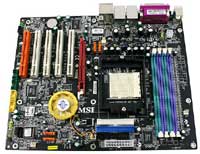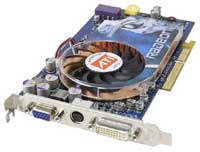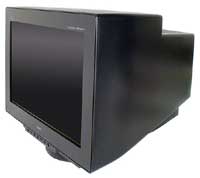High-End Gaming System
We've covered the Mid-Range and Budget sectors, so all that is left is the High-End. While there is a lot of competition in the other sectors, there really are not that many options on the bleeding edge. If money is no object - and it shouldn't be if you're thinking of spending a couple of months' rent on a game system - you can go out and buy the best parts that are available. That is in essence what we have in our High-End rig. However, we really don't recommend that anyone actually spend this much money on a gaming system. A better plan would be to pick out a few of the items that you think are the most worthwhile and stick with the Mid-Range configuration for the remainder of the system.
| High-End AMD Athlon 64 System |
| Hardware |
Recommended Component |
Price |
| Processor |
AMD Athlon 64 FX-55 1MB 2.6 GHz (939) |
877 |
| Motherboard |
MSI K8N Neo2 Platinum |
131 |
| Memory |
2x512MB Crucial Ballistix 2-2-2 1T |
262 |
| Video Card |
Sapphire X800 XT 256 MB GDDR3 AGP |
461 |
| Hard Drive |
Western Digital Raptor 74GB SATA 10000RPM 8MB Model WD740GD |
173 |
| Hard Drive |
Maxtor 300GB SATA 7200RPM 16MB Model 6B300S0 |
207 |
| Optical Drive |
NEC DVD+/-RW Drive Model 3500A |
72 |
| 2nd Optical Drive |
Lite-On 16X DVD-ROM Model SOHD-167T |
30 |
| Sound Card |
Creative Labs Audigy 2 ZS |
75 |
| Case |
Antec Lanboy Aluminum |
88 |
| Power Supply |
Antec True480 480W PSU with Blue LED |
95 |
| Display |
NEC/Mitsubishi FP2141SB-BK 22 |
634 |
| Speakers |
Logitech Z-680 5.1 THX Certified |
236 |
| Keyboard |
Logitech Internet Keyboard |
17 |
| Mouse |
Microsoft IntelliMouse Optical |
24 |
| Bottom Line |
|
3382 |

Click to enlarge. |
The choice of parts in some areas is not all that different from the Mid-Range configuration. Our motherboard recommendation remains with the MSI K8N Neo2 Platinum; even more so than the Mid-Range sector
If you are actually thinking about spending this much money on a computer, waiting for PCI Express motherboards with SLI support would really make sense. In that case, you could go with a 6800GT card now and upgrade your gaming performance with a second 6800GT when you need more performance. We expect the SLI-capable motherboards to begin appearing at retail within the next month. Until we actually see the parts on sale, we will not be listing them as an actual recommendation.
We also continue to go with the same NEC DVD burner as well as the keyboard and mouse. Some people really prefer wireless input devices, but for gaming, we personally continue to prefer wired variants. As before, go with what you're most comfortable using. The other components are all upgraded, but we are reaching the point of diminishing returns. The total system cost is roughly twice that of the Mid-Range system, and yet performance is, at best, maybe 25% faster. Let's look at the specifics.
We start with what is the fastest current processor, the AMD Athlon FX-55. Running at 2.6 GHz and with strained silicon, our initial results have shown it to be faster than any other CPU in games, and those looking for even more performance can try their hand at overclocking it. For the RAM, we have upgraded to some high quality, low latency Crucial Ballistix. With 2-2-2 timings at 200 MHz and low timings all the way up to its maximum clock speed of around 270 MHz, the Crucial RAM performs very well. Any memory that uses the latest Samsung TCCD chips is also worth consideration, and it can usually reach even higher clock speeds. OCZ PC3200 Platinum Rev. 2 is one such example, and we use the Samsung TCCD DIMMs as our standard RAM for testing. If you don't plan on overclocking, however, there's really little to differentiate one set of 2-2-2 timing RAM from another.

Click to enlarge. |
For the graphics card, we have selected ATI's X800 XT chip. The X800 XT Platinum Edition and 6800 Ultra are also possibilities for those who simply must have the best. The X800 XT strikes a nice balance between price and performance, as it outperforms the 6800GT in most games that don't have Doom 3 in the title and it costs $75 less than the slightly faster chips. Sapphire wins this category as the least expensive X800 XT card. For hardcore Doom 3 players, the NVIDIA cards remain the better choice, and if you're interested in SLI, there are two important things to remember. First, of course, is that you need to wait for PCI Express motherboards to become available, which may be a month or two out - we're sure that NVIDIA's partners are trying desperately to get the boards to market before Christmas. The other critical factor is that you will need to "downgrade" to a 6800GT. As the 6800 Ultra is a two-slot design, there will not be room to put two 6800 Ultras in a system - at least, not on the boards that we've seen. Two 6800GT cards are significantly faster than a single 6800 Ultra, though, so the tradeoff is worth it in our book.
Our hard drive selection may be overkill, but we have paired the fastest SATA hard drive available - the Western Digital Raptor - with a fast, but spacious, Maxtor DiamondMax 10 (a.k.a. Maxline-III) drive. The Maxtor drives are so new that we really don't have much data in terms of reliability, so if you have any personal experience with the drives, we'd like to hear from you. On the optical side of things, we have added a standard DVD-ROM drive to the burner, allowing for DVD to DVD copying - or CD to CD copying - if you need it. The speakers are Logitech's Z-680 5.1, which provide great sound at a reasonably affordable price. They compare favorably with Klipsch ProMedia Ultra 5.1 speakers and cost significantly less. We have also thrown in a sound card for good measure - the Creative Audigy 2 ZS is designed with gaming in mind and provides better quality than most integrated solutions as well as slightly better performance.

Click to enlarge. |
Finally, we wrap things up with the case and monitor selections. For the case, we have selected the Antec Super Lanboy paired with an Antec True480 power supply. It is very similar to the SLK3700-BQE in design, but uses an aluminum body instead of steel and has a case window on the side. Two 120 mm fans are included, and it also comes with a carrying harness that can come in handy if you're the type to haul your computer to LAN parties. Lian Li and Silverstone also make some very nice cases if you're willing to spend more money. The majority of high-end cases lack a power supply, so we used an Antec True480 480W PSU. The Antec NeoPower 480 and Ultra X Connect are also alternatives worth considering - they are 480W and 500W respectively, and they have detachable power rails so that you can avoid cluttering up the insides of your case with unused cables.

Click to enlarge. |
Our choice of display is a large 22" (20.0" viewable) NEC monitor. Providing high refresh rates (85 Hz) at even 2048x1536 as well as the ability to run at other resolutions without interpolation - the Achilles heel of LCDs - we still prefer a large CRT to LCDs for games. It also comes with four USB ports, if that sort of thing interests you. There are other 22" NEC CRTs that cost less, but if you want a huge monitor for gaming, you'll want one that supports 2048x1536, as few games support the less common resolutions such as 1920x1440. The drawback for such a CRT is that it is large and heavy, making it less than ideal for transportation to LAN parties.

Click to enlarge. |
If portability is your style, we recommend a good quality 19" LCD instead. Unlike CRTs, an LCD's viewable area is the same as their screen size, so a 19" LCD is really only slightly smaller than a 21/22" CRT (which both have a 20.0" viewable area). Low response times are the most important aspect of LCDs that will be used in gaming, and for this, we recommend the ViewSonic VP912B 19" LCD. With a 12 ms response time, there is virtually no ghosting. It does cost more, but it works great. The native resolution is 1280x1024, but we have not yet encountered any 19" LCDs that support 1600x1200 with a 12 ms response time. Besides, 1280x1024 is not quite as demanding of the GPU as 1600x1200 - if your LCD runs at a native 1600x1200 resolution, you'll need to either lower the resolution when game complexity increases or else, you'll need to upgrade your GPU more often. Neither one is very appealing. Remember also that you want a DVI-D connection on any LCD; otherwise, you're still stuck with an analog signal that can affect image quality, particularly at high resolutions.















70 Comments
View All Comments
Arkali - Tuesday, November 23, 2004 - link
For Intel gaming you should have picked the new AOPEN socket 479 855GME motherboard and a Dothan processor.Glassmaster - Monday, November 22, 2004 - link
#30 Doesn't look like they are going to defend their PSU recommendations. I just want to know if they actually build and stress test these systems with the Generic PSUs to make sure their recommended systems really are reliable.Glassmaster.
Live - Monday, November 22, 2004 - link
I like the format of this guide. I think the guides in general has been a great addition to Anandtech.To bad PCI-e motherboards is not out yet. Since the sli previews are not out in force yet I'm still not 100% sure if its something you want on your motherboard for more upgradability but it sure looks like it is not. Too expensive both in terms of motherboard and the 2 cards. But for a gamer, investing in anything else then PCI-e seems like a bad move. Unless you like to buy second-hand. I bet a lot of AGP cards will soon be available on the market as the high end crowd switches to the latest.
mldeveloper - Monday, November 22, 2004 - link
i like the format of this guide, since i always jumped to the end to see the final price breakdown anyway.nurazlanshah - Monday, November 22, 2004 - link
is the a big difference in fps between 128mb and 256mb for a same graphic card?deathwalker - Monday, November 22, 2004 - link
Jarod...great writeup. Ignore all the sniping. It's a tough job doing a article like this and sometimes there just aren't any absolute rights and wrongs. Somepeople just like to pipe-off and be heard.AaronAxvig - Monday, November 22, 2004 - link
#15 I think if you really wanted maximum performance for a LOT of money, you would go with RAIDed SCSI. Very fast, no?Momental - Monday, November 22, 2004 - link
Fantastic article, Trog......I mean Jarrod. ;)I was considering going the SLI route with (2) two 6600GT's, but then realized that the performance is identical to that of one 6800GT. And who wants to take the chance of one of the GPU's defecating the bed? Additionally, the cost of the SLI-capable board ain't gonna be cheap. I will, however, wait for the VIA and nVidia PCI-e boards to become available before finally building a new system.
The only thing I might change from the mid-range system is to put in the lower latency RAM, such as the OCZ Plat Rev. 2 or the Ballistix. Pop on a good aftermarket HSF on the CPU and we're good to go!!
gilkman - Monday, November 22, 2004 - link
Very nice article. It's been a few years since my last homebuilt but with the new games it's def time to upgrade. I like the format of this article. It gives me a few more options and insight compared to the similar guides they have over at sharkeyextreme.comI am def looking at high end parts to put together and I was very interested in the Dell 20 inch widescreen LCD - Does anyone have any comments on using a widescreen LCD for games? The Dell widescreen has 16MS refresh and high resolutions, and I know that HL2 will support widescreen play, but what about other modern games like RTS's and RPG's? Is it safer to stick with a 4:3 screen?
SDA - Monday, November 22, 2004 - link
Looks good, but I object to using a cheap PSU for a lot of the systems. It's worth the small amount of extra money you pay to get a better PSU... a TON of the problems I've seen in DIY systems resulted from cheapo PSUs that couldn't deliver enough power or simply couldn't deliver clean enough power. Cheap PSU = false savings, IMHO. There are plenty of good PSUs out there for cheap (TTGI, CWT aka Antec).And yeah, sure, the budget rigs don't stress the PSU much. I still hold that you shouldn't go generic. Having looked inside a lot of generic PSUs, I can safely say that I wouldn't ever want to see one in ANY system I build.